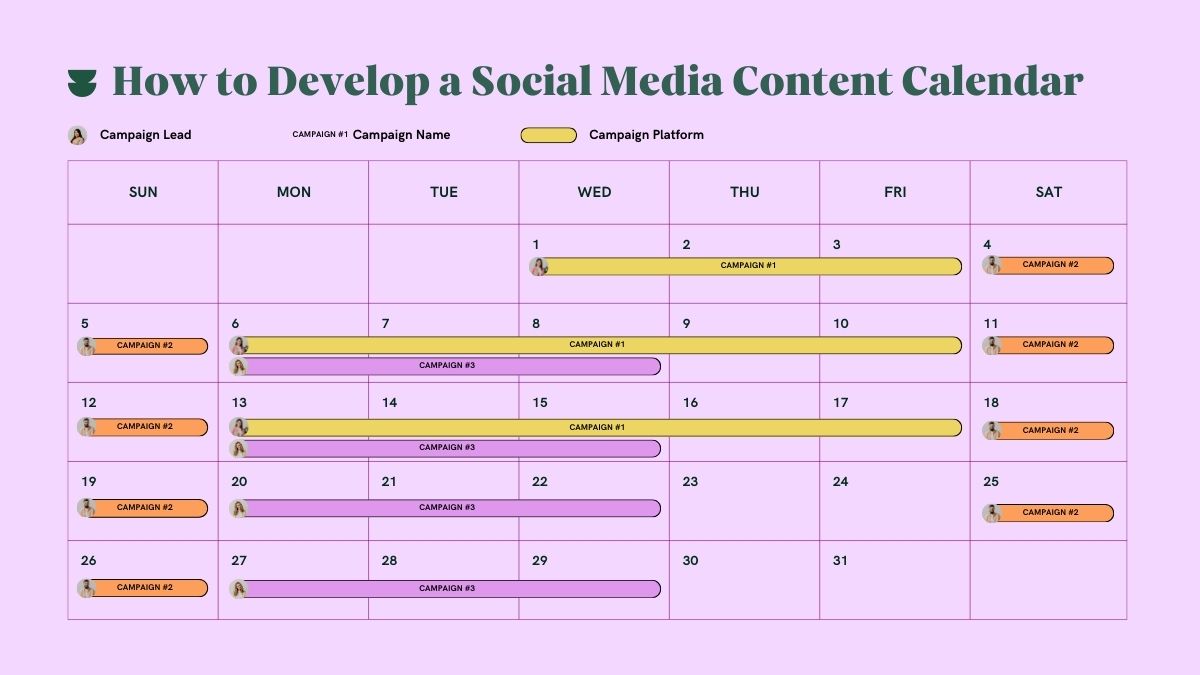
Maintaining a consistent and strategic presence on social media is crucial for any business or personal brand. One of the most effective ways to ensure that your social media efforts are organized, targeted, and consistent is by developing a social media content calendar. A content calendar is not just a schedule; it’s a strategic tool that helps you plan, create, and post content that aligns with your marketing goals, engages your audience, and strengthens your brand’s online presence. In this comprehensive guide, we’ll walk you through the steps to create an effective social media content calendar that will help you stay on top of your social media game.
Why You Need a Social Media Content Calendar
- Consistency: Posting regularly and consistently keeps your audience engaged and helps build trust with your followers. A content calendar ensures that you never miss a posting date and that your content is spaced out in a way that keeps your audience engaged without overwhelming them.
- Strategic Planning: A content calendar allows you to plan your content in advance, aligning it with your marketing goals, product launches, events, and seasonal promotions. This strategic approach ensures that your social media efforts support your overall business objectives.
- Time Management: With a content calendar, you can batch-create content in advance, saving you time and reducing the stress of last-minute posts. This allows you to focus on other important aspects of your business while still maintaining a strong social media presence.
- Content Variety: Planning your content in advance allows you to ensure a good mix of content types, such as promotional posts, educational content, user-generated content, and behind-the-scenes looks. This variety keeps your audience interested and engaged.
- Tracking and Optimization: A content calendar provides a framework for tracking the performance of your posts. By reviewing the success of different types of content, you can optimize your strategy over time, focusing on what works best for your audience.
Steps to Develop a Social Media Content Calendar
1. Define Your Social Media Goals
Before you start creating your content calendar, it’s essential to define your social media goals. What do you want to achieve with your social media presence? Common goals include:
- Brand Awareness: Increasing the visibility of your brand.
- Engagement: Building a community and encouraging interaction with your audience.
- Lead Generation: Attracting potential customers to your website or business.
- Sales: Driving direct sales through social media platforms.
- Customer Support: Providing a channel for customer service and support.
Clearly defined goals will guide your content strategy and ensure that every post serves a purpose.
2. Understand Your Audience
Knowing your audience is crucial for creating content that resonates with them. Consider the following when analyzing your audience:
- Demographics: Age, gender, location, education level, and occupation.
- Interests: What topics, activities, or hobbies are they interested in?
- Pain Points: What challenges or problems do they face that your product or service can solve?
- Social Media Behavior: Which platforms do they use, and when are they most active?
Understanding your audience will help you tailor your content to their preferences and needs, increasing the likelihood of engagement.
3. Choose Your Social Media Platforms
Not all social media platforms are created equal, and not every platform will be right for your brand. Choose the platforms that align with your goals and where your audience is most active. Common platforms include:
- Facebook: Great for community building, customer engagement, and paid advertising.
- Instagram: Ideal for visually appealing content, lifestyle brands, and influencers.
- Twitter: Best for real-time updates, customer service, and industry news.
- LinkedIn: Perfect for B2B marketing, professional content, and networking.
- Pinterest: Suited for visual content, DIY, and e-commerce.
- TikTok: Ideal for short-form video content and reaching younger audiences.
Each platform has its own strengths and audience, so choose the ones that will help you achieve your specific goals.
4. Conduct a Content Audit
Before creating new content, it’s helpful to review your existing content to see what has worked well in the past. Conduct a content audit by analyzing the performance of your past social media posts. Look for patterns in the types of content that generated the most engagement, such as likes, shares, comments, and click-through rates. This information will help you identify the content types and topics that resonate with your audience.
5. Plan Your Content Types and Themes
A well-rounded social media strategy includes a variety of content types and themes. Some common content types include:
- Educational Content: How-to guides, tips, industry news, and infographics.
- Promotional Content: Product launches, discounts, and special offers.
- Engagement Content: Polls, quizzes, questions, and contests.
- User-Generated Content: Customer reviews, testimonials, and photos.
- Behind-the-Scenes Content: Sneak peeks, employee highlights, and company culture.
- Seasonal Content: Holiday-themed posts, event promotions, and seasonal tips.
Themes can be based on specific days of the week (e.g., #MondayMotivation, #ThrowbackThursday) or topics relevant to your brand (e.g., sustainability, innovation, community involvement).
6. Create a Content Calendar Template
Now that you have a clear idea of what content you want to create, it’s time to set up your content calendar. You can use a variety of tools to create your calendar, such as:
- Google Sheets or Excel: Simple and customizable, great for small teams.
- Project Management Tools: Platforms like Trello, Asana, or Monday.com offer built-in calendar features and collaboration tools.
- Social Media Management Tools: Tools like Hootsuite, Buffer, or Sprout Social allow you to schedule posts directly from the calendar.
Your content calendar template should include the following columns:
- Date: The date the content will be published.
- Platform: The social media platform where the content will be posted.
- Content Type: The type of content (e.g., blog post, video, infographic).
- Topic/Theme: The main theme or topic of the content.
- Copy: The text or caption for the post.
- Visuals: Any images, videos, or graphics that accompany the post.
- Links: Any URLs that should be included in the post.
- Call to Action: What you want your audience to do after seeing the post (e.g., visit your website, share the post, sign up for a newsletter).
- Performance Metrics: A section for tracking the performance of the post (e.g., likes, shares, comments, clicks).
7. Schedule Your Posts
With your content planned out and your calendar template ready, it’s time to start scheduling your posts. Depending on the tools you’re using, you may be able to schedule posts directly from your content calendar. If you’re using a manual calendar, set aside time each week or month to schedule your posts on each platform.
When scheduling, consider the best times to post on each platform. For example:
- Facebook: Generally, the best times to post are between 9 AM and 1 PM on weekdays.
- Instagram: Posting during lunchtime (11 AM – 1 PM) and evenings (7 PM – 9 PM) tends to work well.
- Twitter: Weekdays between 9 AM and 3 PM are typically the best times to post.
- LinkedIn: Posting during business hours (8 AM – 5 PM) on weekdays is most effective.
Each audience is different, so it’s important to experiment with different posting times and analyze your performance metrics to determine what works best for your brand.
8. Monitor and Adjust Your Strategy
Your social media content calendar is a living document that should evolve over time. Regularly review your calendar to assess what’s working and what’s not. Use the performance metrics you’ve been tracking to identify trends, and adjust your strategy accordingly. Don’t be afraid to experiment with new content types, themes, or posting times to see how your audience responds.
Conclusion
Developing a social media content calendar is an essential step in creating a consistent, strategic, and effective social media presence. By following these steps, you’ll be able to plan, create, and schedule content that resonates with your audience, aligns with your goals, and ultimately helps you grow your brand online. Remember, the key to success is staying organized, being consistent, and continuously analyzing and optimizing your strategy. With a well-crafted content calendar, you’ll be well on your way to social media success.




